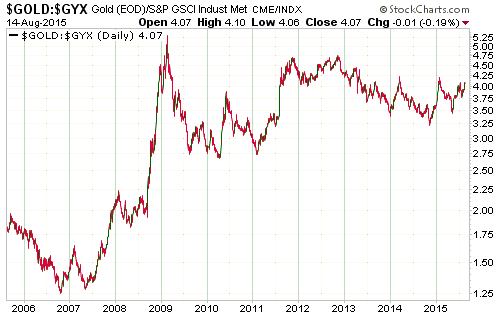Gold’s safe-haven status is not in doubt Steve Saville
email: sas888_hk@yahoo.com
Posted Jul 24, 2015 Below is an excerpt from a commentary posted at www.speculative-investor.com on 16th August 2015. Excerpts from our newsletters and other comments on the markets can be read at our blog.
Gold is very different from all other commodities. This is due to physical characteristics that caused it to be money for thousands of years and led to its aboveground supply becoming orders of magnitude greater than its annual production*. However, despite the huge size of its existing aboveground supply relative to the rate at which new supply is created, that is, despite its massive stocks-to-flow ratio, gold is still a commodity and its US$ price is still affected by the overall trend in commodity prices. In particular, a major decline in commodity prices will naturally put downward pressure on the gold price and a major advance in commodity prices will naturally put upward pressure on the gold price. That's why gold's performance can be most clearly 'seen' by comparing it to the performances of other commodities, with the most appropriate comparison being with 'non-monetary' metals**. Such a comparison reveals that gold has performed exactly as a safe haven should have performed given the economic and financial-market backdrops.
In particular and with reference to the following chart, we point out that the gold/GYX ratio (the gold price relative to the price of a basket of industrial metals) rocketed upward from mid-2007 through to early-2009 in response to the global financial crisis and severe economic recession of the period. The early-2009 high was an all-time high, which was a reflection of an extremely low level of general confidence in economic prospects and the abilities of central banks. The gold/GYX ratio then pulled back sharply as the crisis abated and an economic recovery got underway, but it stopped declining in the first half of 2010. Since then it has been making lower highs and higher lows, with a euro-zone (EZ) crisis causing a rise to just below the all-time high in 2011-2012, the semblance of economic stability in both the EZ and the US causing a steady slide from late-2012 through to late-2014, and the re-emergence of fears regarding EZ stability causing a couple of bounces over the past 9 months.
At the end of last week the gold/GYX ratio was near a 2-year high and close to the middle of the wide range that was established during 2009-2010. Note that by historical standards this wide range is at an elevated level. 
There is currently a higher-than-average amount of confidence in the Fed, the US stock market and the US economy, which suggests to us that the gold/GYX ratio is now as high as it should be. However, we strongly believe that this confidence is misplaced and will erode over time, causing the gold/GYX ratio to break above its 2009 peak.
Unfortunately, we can't predict when it will happen. We thought that it would have happened by now, but, despite a lot of evidence to the contrary, a critical mass of people remains convinced that better economic times lie around the next corner. *Gold's aboveground supply is so large relative to annual mine production that changes in the latter can safely be ignored when looking for price clues. **Gold is no longer money in the true meaning of the word, but it still trades as if it were. ### Aug 16, 2015
Steve Saville
 email: sas888_hk@yahoo.com email: sas888_hk@yahoo.com
Hong Kong Regular financial market forecasts and analyses are provided at our web site:
http://www.speculative-investor.com/new/index.html. We aren't offering a free trial subscription at this time, but free samples of our work (excerpts from our regular commentaries) can be viewed at: http://tsi-blog.com
Copyright ©2002-2019 speculative-investor.com All Rights Reserved. Saville Archives 321gold Ltd

| 
